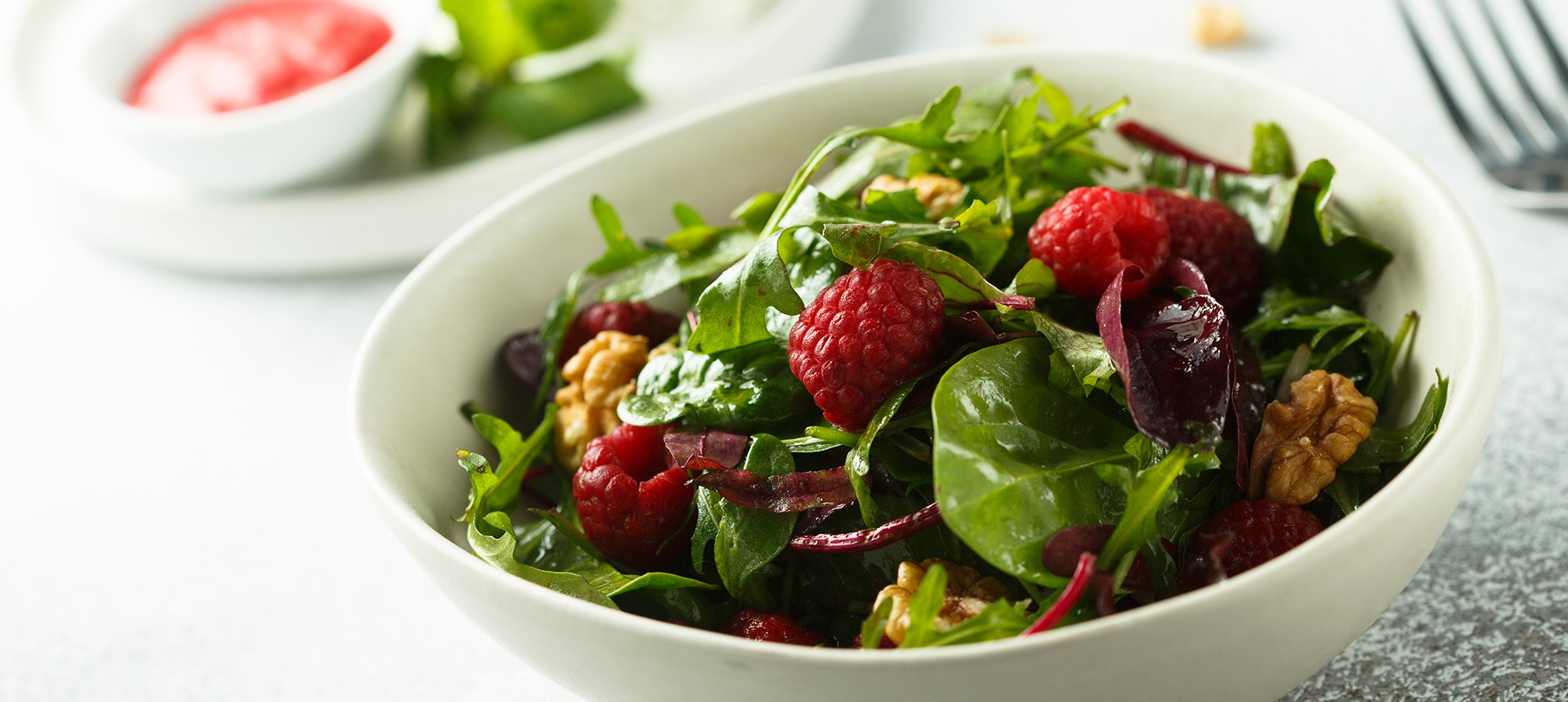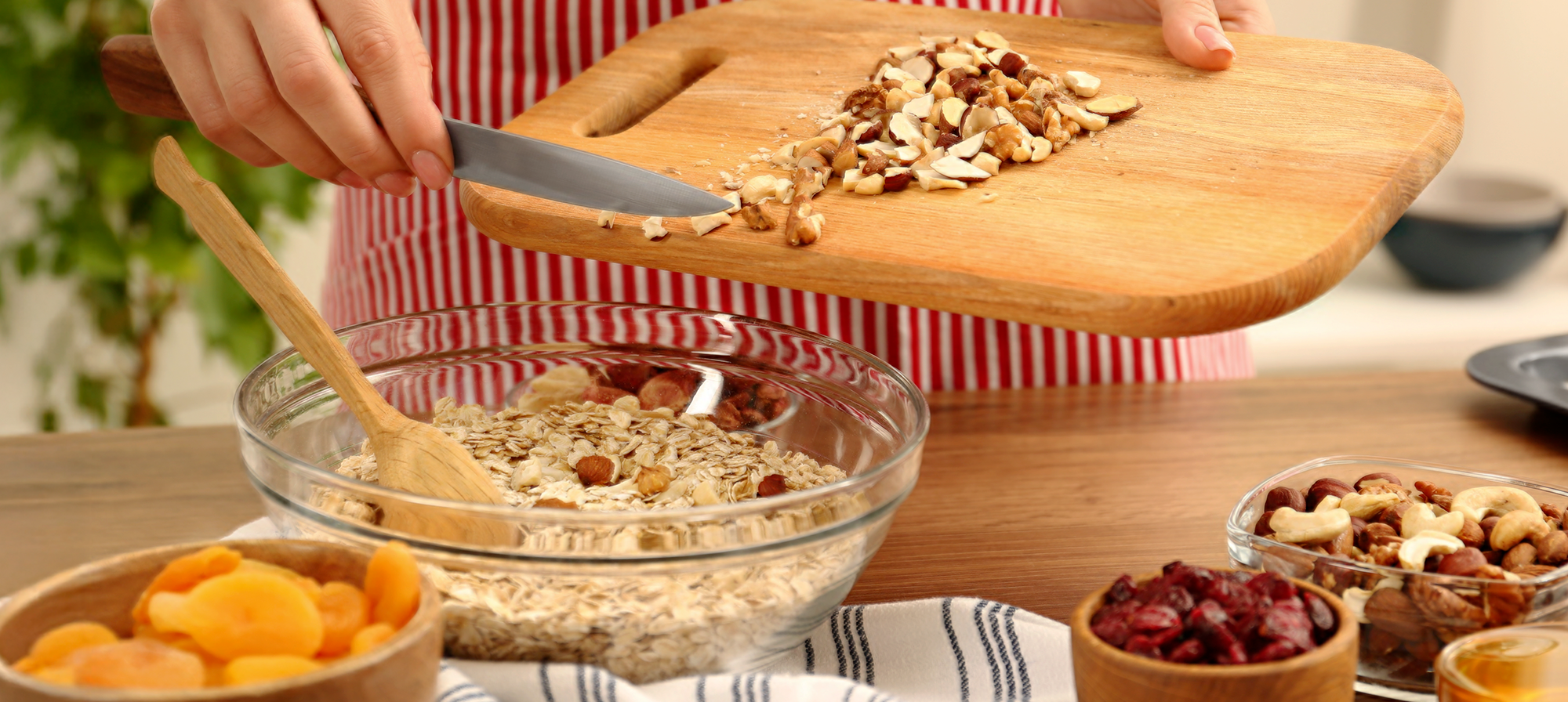Don’t love the taste of spinach? Here’s an easy fix: Top your spinach salad with a host of flavorful foods and sweeten it with raspberry dressing.
This spinach salad recipe blends many flavors and textures into a tasty dish. Raspberry dressing adds a hint of sweetness. Walnuts and carrots bring crunch. And the red onions add a bit of spice, as well as some extra crunch.
Spinach Salad With Raspberry Dressing
Ingredients
- 1 cup fresh spinach, chopped
- 1 cup carrots, sliced
- 1 cup mushrooms, sliced
- 1 cup tomatoes, chopped
- ¼ cup red onions, sliced
- ¼ cup raspberry vinegar dressing (Buy or make your own.)
- 1 tablespoon canola oil
- 2 tablespoons unsalted walnuts, chopped
Directions
In a large bowl, combine spinach, carrots, mushrooms, tomatoes, and red onions. Mix raspberry vinegar dressing and canola oil, then add to veggie mixture. Sprinkle with walnuts.
Yield: 4 servings
Prep Time: 10 minutes
Difficulty: Easy
| Nutrition Facts |
| Calories 107 |
| Fat calories 57 |
| Total fat 6.3g |
| Saturated fat 0.5g |
| Cholesterol 0mg |
| Sodium 226.9mg |
| Total carbohydrate 12.2g |
| Dietary fiber 2.1g |
| Sugars 8g |
| Protein 2.7g |
Here’s the lowdown on the many health perks the ingredients in this spinach salad recipe have to offer.
Spinach
There’s a reason Popeye ate so much of it. This leafy green is a real superstar. Some research shows it can boost eye health, lower the risk of cancer, and help support healthy blood pressure. These and other perks come from vitamins like A, C, and K. Spinach is also packed with potassium, phosphorus, calcium, and iron. And the fiber in spinach is great for digestive health. Get a list of fermented foods that can also help boost your gut health.

Carrots
These sweet root vegetables are a fine source of vitamin A, which can help your body fight infections and support eye health. Some research also suggests that carrots can help support healthy cholesterol levels and protect your heart. Plus, they’re great for keeping your weight in check. They’re low in calories and high in fiber, which helps fill you up and keep hunger pangs at bay for longer. Learn how nutrient-rich foods help fuel your body.

Tomatoes
Summer and early fall are the best seasons to enjoy fresh tomatoes. These sweet, juicy veggies—which are technically fruits—are loaded with vitamins C, A, B9 (folate), and K, as well as potassium. And tomatoes are brimming with the antioxidant lycopene, which research suggests may help lower the risk of certain cancers. Lycopene also helps support healthy cholesterol levels and slow the formation of artery-stiffening plaque. These, in turn, help support your blood vessel and heart health.

Mushrooms
Everyone’s favorite fungus, mushrooms bring a savory flavor to many dishes. Plus, they’re high in B vitamins, which can help boost mood and may even protect against depression. Mushrooms are also a good source of an amino acid known as glutamate. It’s thought to enhance signals between brain cells. Thus, it may support better learning and memory.

Red onions
Sure, they add a great pop of color to the dish. But red onions also give a spicy flavor without salt. Antioxidants in red onions, such as quercetin and vitamin C, may help lower inflammation and protect your cells against harm. And while more research is needed, one study found that quercetin may play a role in keeping blood sugar in healthy ranges.
 Walnuts
Walnuts
Walnuts are great in savory dishes, like this salad. They’re loaded with omega-3 fats. Research suggests that these fats help lower blood levels of LDL cholesterol and triglycerides. This, in turn, may help support heart and blood vessel health. Here’s one collection of studies that shows how walnuts may help lower the risk for heart disease.

Whether you enjoy this salad as a side or a main dish, it will be a welcome addition to your food plan.
Looking for another tasty yet healthy salad recipe? Here’s one that’s high in protein and flavored with a tangy ginger-sesame dressing.
Not a Silver&Fit® member? Learn more about everything the program has to offer, including more helpful healthy living tips like this, here on our website.
This information is not intended to take the place of regular medical care or advice. Please check with your doctor before using this information or beginning any self-care program. Images used for this article do not depict any members of the Silver&Fit program.
References
Cleveland Clinic. (2020, November 12). Kale vs. spinach: Which is heart-healthier? https://health.clevelandclinic.org/kale-vs-spinach-which-is-heart-healthier/
Cleveland Clinic. (2021, March 23). Reasons why carrots (of all colors) are healthy for you. https://health.clevelandclinic.org/reasons-why-carrots-of-all-colors-are-healthy-for-you/
Cleveland Clinic. (2022, April 25). Glutamate. https://my.clevelandclinic.org/health/articles/22839-glutamate
Cleveland Clinic. (2023, January 17). The health benefits of nuts. https://health.clevelandclinic.org/benefits-of-nuts
Eid, H. M., & Haddad, P. S. (2017). The antidiabetic potential of quercetin: Underlying mechanisms. Current Medicinal Chemistry, 24(4), 355-364. https://doi.org/10.2174/0929867323666160909153707
Fulgoni, V. L., III, & Agarwal, S. (2021). Nutritional impact of adding a serving of mushrooms on usual intakes and nutrient adequacy using National Health and Nutrition Examination Survey 2011-2016 data. Food Science & Nutrition, 9(3), 1504-1511. https://doi.org/10.1002/fsn3.2120
Guasch-Ferre, M., Li, J., Hu, F. B., Salas-Salvado, J., & Tobias, D. K. (2018). Effects of walnut consumption on blood lipids and other cardiovascular risk factors: An updated meta-analysis and systematic review of controlled trials. The American Journal of Clinical Nutrition, 108(1), 174-187. https://doi.org/10.1093/ajcn/nqy091
Hall-Flavin, D. K. (2025, February 19). Vitamin B-12 and depression: Are they related? Mayo Clinic. https://www.mayoclinic.org/diseases-conditions/depression/expert-answers/vitamin-b12-and-depression/faq-20058077
Harvard T. H. Chan School of Public Health. (n.d.). Mushrooms. The Nutrition Source. https://www.hsph.harvard.edu/nutritionsource/food-features/mushrooms/
MedlinePlus. (2023, January 19). Amino acids. U.S. Department of Health and Human Services, National Institutes of Health, National Library of Medicine. https://medlineplus.gov/ency/article/002222.htm
Shmerling, R. H. (2024, August 7). Health benefits of walnuts. Harvard Health Publishing. https://www.health.harvard.edu/blog/health-benefits-of-walnuts-2018081314526
Swartzendruber, K. (2018, July 17). Tomatoes provide many health benefits. Michigan State University Extension. https://www.canr.msu.edu/news/tomatoes_provide_many_health_benefits
United States Department of Agriculture. (2020, April 1). Onions, red, raw. https://fdc.nal.usda.gov/food-details/790577/nutrients
United States Department of Agriculture. (2021, October 28). Spinach, mature. https://fdc.nal.usda.gov/food-details/1999633/nutrients
This article was written by Gail Olson, edited by Nora Byrne, and clinically reviewed by Elizabeth Thompson, MPH, RDN, on May 2, 2025.





